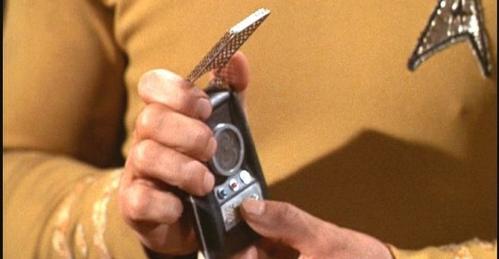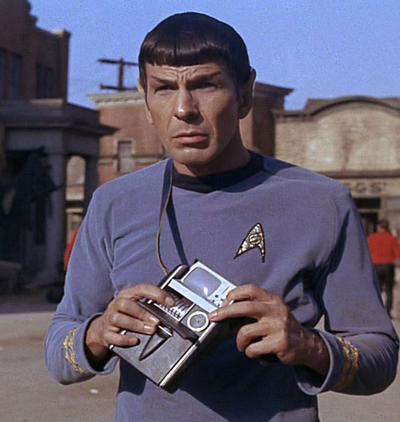
It’s hard to determine the full effect the original Star Trek had on technology. Back when the show first ran, the phasers, tricorders, and communicators were nothing more than science fiction, nowhere near as real as cars, telephones, and other aspects of daily life. So many of the products used in the 1960s have gone out of style or are being rendered obsolete. If an item was lucky it became a collectible, or like vintage Ford Mustang parts, prized among a selective group of individuals. But where’s the made-up equipment of the Star Trek universe? Is there any Star Trek technology on the horizon?
Cell Phones, Kirk, and Uhuru
Consider the humble communicator, used by Kirk in so many episodes to call in an emergency beam-up (usually after he ran out of red-shirted coworkers). You see that same design everywhere in small, flip-open cell phones.

Why do so many cell phones bear more than a passing resemblance to a 1960s sci-fi device? Well, quite frankly, cell phone technology is often designed by sci-fi geeks, and we’ve wanted communicators since the first time Kirk flipped one open. Heck, copyright issues are probably the only reason flip-open phones don’t make a communicator’s characteristic beep-beep sound.
There’s a less flippant explanation though. The communicator, as designed by the Star Trek prop department, is everything you’d need in a portable communication device. It’s small, sturdy, and packs a service range far out of proportion to its size. In short, Gene Roddenberry and his team designed the perfect mobile phone. They just didn’t know it.
And what about Uhuru, the Enterprise’s communication office? Chances are when you think of her you think of two things: a mini-skirt that could better be described as a wide belt, and a funny-looking device sticking out of her ear.

A device that relays communication signals to her so she can hear and respond without distracting the rest of the crew. Yeah, if that didn’t inspire the designers of Bluetooth headsets, nothing did.
Spock, McCoy, and the Tricorder
The communicator was cool, and the phaser was exciting, but it was the tricorder that really caught people’s imagination: a small, portable device capable of analyzing and diagnosing almost anything. While we’re not there yet, portable medical devices are becoming increasingly complicated.

In January 2012, the X Prize Foundation announced a $10 million dollar contest to create portable medical devices capable of recording a person’s blood pressure, pulse, temperature, and respiratory rate. Under the terms of the Foundation’s contest, the device must weigh no more than five pounds (a tad heavier than anything Dr. McCoy ever carried) and should diagnose up to fifteen diseases.
The idea sounds far-fetched until you realize that previous X Prize Foundation contests lead to technological advances in fields as diverse as genome sequencing, robotics, and private-sector spaceflight. And no one’s even trying to pretend that the final product will be called anything other than a tricorder.